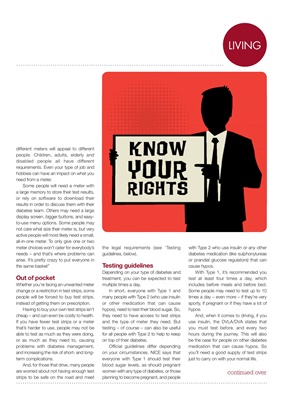
KITLIVING
different meters will appeal to different
people. Children, adults, elderly and
disabled people all have different
requirements. Even your type of job and
hobbies can have an impact on what you
need from a meter.
Some people will need a meter with
a large memory to store their test results,
or rely on software to download their
results in order to discuss them with their
diabetes team. Others may need a large
display screen, bigger buttons, and easyto-use menu options. Some people may
not care what size their meter is, but very
active people will most likely need a small,
all-in-one meter. To only give one or two
meter choices won't cater for everybody's
needs - and that's where problems can
arise. It's pretty crazy to put everyone in
the same basket"
Out of pocket
Whether you're facing an unwanted meter
change or a restriction in test strips, some
people will be forced to buy test strips,
instead of getting them on prescription.
Having to buy your own test strips isn't
cheap - and can even be costly to health.
If you have fewer test strips or a meter
that's harder to use, people may not be
able to test as much as they were doing,
or as much as they need to, causing
problems with diabetes management,
and increasing the risk of short- and longterm complications.
And, for those that drive, many people
are worried about not having enough test
strips to be safe on the road and meet
the legal requirements (see 'Testing
guidelines, below).
Testing guidelines
Depending on your type of diabetes and
treatment, you can be expected to test
multiple times a day.
In short, everyone with Type 1 and
many people with Type 2 (who use insulin
or other medication that can cause
hypos), need to test their blood sugar. So,
they need to have access to test strips
and the type of meter they need. But
testing - of course - can also be useful
for all people with Type 2 to help to keep
on top of their diabetes.
Official guidelines differ depending
on your circumstances. NICE says that
everyone with Type 1 should test their
blood sugar levels, as should pregnant
women with any type of diabetes, or those
planning to become pregnant, and people
with Type 2 who use insulin or any other
diabetes medication (like sulphonylureas
or prandial glucose regulators) that can
cause hypos.
With Type 1, it's recommended you
test at least four times a day, which
includes before meals and before bed.
Some people may need to test up to 10
times a day - even more - if they're very
sporty, if pregnant or if they have a lot of
hypos.
And, when it comes to driving, if you
use insulin, the DVLA/DVA states that
you must test before, and every two
hours during the journey. This will also
be the case for people on other diabetes
medication that can cause hypos. So
you'll need a good supply of test strips
just to carry on with your normal life.
continued over